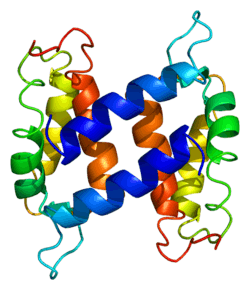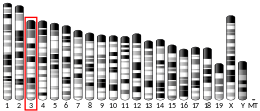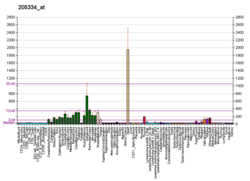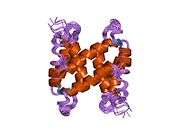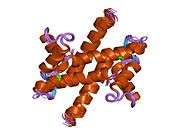S100A1
S100A1, also known as S100 calcium-binding protein A1 is a protein which in humans is encoded by the S100A1 gene.[5][6] S100A1 is highly expressed in cardiac and skeletal muscle, and localizes to Z-discs and sarcoplasmic reticulum. S100A1 has shown promise as an effective candidate for gene therapy to treat post-myocardially infarcted cardiac tissue.
Structure
S100A1 is a member of the S100 family of proteins expressed in cardiac muscle, skeletal muscle and brain,[7] with highest density at Z-lines and sarcoplasmic reticulum.[8] S100A1 contains 4 EF-hand calcium-binding motifs in its dimerized form,[9] and can exist as either a hetero or homodimer. The S100A1 homodimer is high affinity (nanomolar range or tighter), and is formed through hydrophobic packing of an X-type 4-helix bundle created between helices 1, 1', 4, and 4'. Protein nuclear magnetic resonance spectroscopy structural information on the homodimeric form of this protein shows that each monomer is helical and contains two EF-hand calcium-binding loops; one in the N-terminus and a canonical EF hand in the C-terminus having higher calcium affinity (dissociation constant of roughly 20 micromolar). The two EF hand domains neighbor each other in three dimensional space, and are connected to each other through a short beta sheet region (residues 27–29 and 68–70).
Upon binding calcium, helix 3 of S100A1 re-orients from being relatively antiparallel to helix 4 to being roughly perpendicular. This conformational change is different from most EF hands, in that the entering helix, and not the exiting helix, moves. This conformational change exposes a large hydrophobic pocket between helix 3, 4, and the hinge region of S100A1 that is involved in virtually all calcium-dependent target protein interactions. These biophysical properties seem to be well conserved across the S100 family of proteins. Helix 3, 4, and the hinge region are the most divergent areas between individual S100 proteins, and so it is likely that the sequence of these regions is pivotal in fine-tuning calcium-dependent target binding by S100 proteins.[10] S-Nitrosylation of S100A1 at Cys85 reorganizes the conformation of S100A1 at the C-terminal helix and the linker connecting the two EF hand domains.[11]
The most accurate high-resolution solution structure of human apo-S100A1 protein (PDB accession code: 2L0P) has been determined by means of NMR spectroscopy in 2011.[12]
S100 genes include at least 19 members which are located as a cluster on chromosome 1q21.[13][14]
Function
S100 proteins are localized in the cytoplasm and/or nucleus of a wide range of cells, and involved in the regulation of a number of cellular processes such as cell cycle progression and differentiation. This protein may function in stimulation of Ca2+-induced Ca2+ release, inhibition of microtubule assembly, and inhibition of protein kinase C-mediated phosphorylation.
S100A1 is expressed during development in the primitive heart at embryonic day 8 in levels that are similar between atria and ventricles. As development progresses up to embryonic day 17.5, S100A1 expression shifts to a lower levels in atria and higher levels in ventricular myocardium.[15]
S100A1 has shown to be a regulator of myocardial contractility. S100A1 overexpression via adenoviral gene transfer in adult rabbit cardiomyocytes or a cardiac-restricted S100A1 murine transgenic enhanced cardiac contractile performance by increasing sarcoplasmic reticular calcium transients and uptake, altering the calcium sensitivity and cooperativity of myofibrils, enhancing SERCA2A activity and enhancing calcium-induced calcium release.[16][17][18] Specifically, S100A1 increases the gain of excitation-contraction coupling[19] and decreases calcium spark frequency[20] in cardiomyocytes. Enhancement of L-type calcium channel transsarcolemmal calcium influx by S100A has been shown to be dependent on protein kinase A.[21] Effects of S100A1 on myofilament proteins may be via Titin; S100A1 has been shown to interact with the PEVK region of Titin in a calcium-dependent manner, and its binding reduces the force in an in vitro motility assay, suggesting that S100A may modulate Titin-based passive tension prior to systole.[22][23] In mice with ablation of the S100A1 gene (S100A1-/-), cardiac reserve upon beta adrenergic stimulation was impaired, showing reduced contraction rate and relaxation rate, as well as reduced calcium sensitivity. However, S100A1-/- did not show the eventual cardiac hypertrophy or chamber dilation in aged mice.[24]
In animal models of disease, S100A1 protein levels has been shown to be altered in right ventricular hypertrophied tissue in a model of pulmonary hypertension;[25] several tissue types (brain, skeletal muscle and cardiac muscle) in a model of type I diabetes mellitus;[26] S100A1 has been demonstrated as a regulator of the genetic program underlying cardiac hypertrophy, in that S100A1 inhibits alpha1 adrenergic stimulation of hypertrophic genes, including MYH7, ACTA1 and S100B.[27] In a rat model of myocardial infarction, intracoronary S100A1 adenoviral gene transfer restored sarcoplasmic reticular calcium transients and load, normalized intracellular sodium concentrations, reversed the pathologic expression of the fetal gene program, restored energy supply, normalized contractile function, preserved inotropic reserve, and reduced cardiac hypertrophy 1 week post-myocardial infarction.[28][29] In support of the adenoviral experiments, S100A1 transgenic overexpressing mice subjected to myocardial infarction showed preserved contractile function, abrogated apoptosis, preserved sarcoplasmic reticulum calcium cycling and beta adrenergic signaling, prevention from cardiac hypertrophy and heart failure, as well as prolonged survival relative to non-transgenic controls.[30][31]
S100A1 has also been identified as a novel regulator of endothelial cell post-ischemic angiogenesis, as patients with limb ischemia exhibited downregulation of S100A1 expression in hypoxic tissue.[32][33]
In melanocytic cells, S100A1 gene expression may be regulated by MITF.[34]
Clinical Significance
S100A1 has shown efficacy in feasibility in treating heart failure symptoms in large, preclinical models and human cardiomyocytes,[35][36] and thus shows great promise for clinical trials.[37][38][39][40][41][42][43]
Reduced expression of this protein has been implicated in cardiomyopathies,[44] and left ventricular assist device-based therapy does not restore S100A1 levels in patients.[45] S100A1 has shown promise as an early diagnostic biomarker for acute myocardial ischemia, presenting with a distinct timecourse in human plasma following an ischemic event relative to traditional markers creatine kinase, CKMB and troponin I.[46][47] This injury-released, extracellular pool of S100A1 was investigated in neonatal murine cardiomyocytes and was shown to prevent apoptosis via an ERK1/2-dependent pathway, suggesting that the release of S100A1 from injured cells is an intrinsic survival mechanism for viable myocardium.[48] S100 has also shown promise as a biomarker for uncontrolled hyperoxic reoxygenation during cardiopulmonary bypass in infants with cyanotic heart disease[49] and in adults.[50] S100A1 gene transfer to engineered heart tissue was shown to augment contractile performance of the tissue implants, suggesting that S100A1 may be effective in facilitating cardiac tissue replacement therapy in heart failure patients.[51] However, the clinical efficacy of this strategy remains to be determined. In addition, multiple drugs, including Pentamidine,[10] Amlexanox, Olopatadine, Cromolyn, and Propanolol,[10] are known to bind to S100A1, although their affinities are often in the mid-micromolar range.
Interactions
S100 interacts with
- PGM1[52]
- S100B[53][54][55]
- S100A4[53][56]
- TRPM3[57]
- Titin[22]
- RYR2[16][58][59]
- SERCA2A[60][61]
- PLB[60]
- RYR1[62]
References
- GRCh38: Ensembl release 89: ENSG00000160678 - Ensembl, May 2017
- GRCm38: Ensembl release 89: ENSMUSG00000044080 - Ensembl, May 2017
- "Human PubMed Reference:". National Center for Biotechnology Information, U.S. National Library of Medicine.
- "Mouse PubMed Reference:". National Center for Biotechnology Information, U.S. National Library of Medicine.
- "Entrez Gene: S100A1 S100 calcium binding protein A1".
- Morii K, Tanaka R, Takahashi Y, Minoshima S, Fukuyama R, Shimizu N, Kuwano R (February 1991). "Structure and chromosome assignment of human S100 alpha and beta subunit genes". Biochemical and Biophysical Research Communications. 175 (1): 185–91. doi:10.1016/S0006-291X(05)81218-5. PMID 1998503.
- Engelkamp D, Schäfer BW, Erne P, Heizmann CW (October 1992). "S100 alpha, CAPL, and CACY: molecular cloning and expression analysis of three calcium-binding proteins from human heart". Biochemistry. 31 (42): 10258–64. doi:10.1021/bi00157a012. PMID 1384693.
- Maco B, Mandinova A, Dürrenberger MB, Schäfer BW, Uhrík B, Heizmann CW (2001). "Ultrastructural distribution of the S100A1 Ca2+-binding protein in the human heart". Physiological Research. 50 (6): 567–74. PMID 11829317.
- Marenholz I, Heizmann CW, Fritz G (October 2004). "S100 proteins in mouse and man: from evolution to function and pathology (including an update of the nomenclature)". Biochemical and Biophysical Research Communications. 322 (4): 1111–22. doi:10.1016/j.bbrc.2004.07.096. PMID 15336958.
- Wright, NT; Cannon, BR; Zimmer, DB; Weber, DJ (1 May 2009). "S100A1: Structure, Function, and Therapeutic Potential". Current Chemical Biology. 3 (2): 138–145. doi:10.2174/2212796810903020138. PMC 2771873. PMID 19890475.
- Lenarčič Živković, M; Zaręba-Kozioł, M; Zhukova, L; Poznański, J; Zhukov, I; Wysłouch-Cieszyńska, A (23 November 2012). "Post-translational S-nitrosylation is an endogenous factor fine tuning the properties of human S100A1 protein". The Journal of Biological Chemistry. 287 (48): 40457–70. doi:10.1074/jbc.m112.418392. PMC 3504761. PMID 22989881.
- Nowakowski M, Jaremko Ł, Jaremko M, Zhukov I, Belczyk A, Bierzyński A, Ejchart A (May 2011). "Solution NMR structure and dynamics of human apo-S100A1 protein". Journal of Structural Biology. 174 (2): 391–9. doi:10.1016/j.jsb.2011.01.011. PMID 21296671.
- Donato R (July 1999). "Functional roles of S100 proteins, calcium-binding proteins of the EF-hand type". Biochimica et Biophysica Acta (BBA) - Molecular Cell Research. 1450 (3): 191–231. doi:10.1016/s0167-4889(99)00058-0. PMID 10395934.
- Wicki R, Schäfer BW, Erne P, Heizmann CW (October 1996). "Characterization of the human and mouse cDNAs coding for S100A13, a new member of the S100 protein family". Biochemical and Biophysical Research Communications. 227 (2): 594–9. doi:10.1006/bbrc.1996.1551. PMID 8878558.
- Kiewitz R, Lyons GE, Schäfer BW, Heizmann CW (December 2000). "Transcriptional regulation of S100A1 and expression during mouse heart development". Biochimica et Biophysica Acta (BBA) - Molecular Cell Research. 1498 (2–3): 207–19. doi:10.1016/s0167-4889(00)00097-5. PMID 11108964.
- Most P, Remppis A, Pleger ST, Löffler E, Ehlermann P, Bernotat J, Kleuss C, Heierhorst J, Ruiz P, Witt H, Karczewski P, Mao L, Rockman HA, Duncan SJ, Katus HA, Koch WJ (September 2003). "Transgenic overexpression of the Ca2+-binding protein S100A1 in the heart leads to increased in vivo myocardial contractile performance". The Journal of Biological Chemistry. 278 (36): 33809–17. doi:10.1074/jbc.M301788200. PMID 12777394.
- Remppis A, Most P, Löffler E, Ehlermann P, Bernotat J, Pleger S, Börries M, Reppel M, Fischer J, Koch WJ, Smith G, Katus HA (2002). "The small EF-hand Ca2+ binding protein S100A1 increases contractility and Ca2+ cycling in rat cardiac myocytes". Basic Research in Cardiology. 97 Suppl 1 (7): I56–62. doi:10.1007/s003950200031. PMID 12479236.
- Most P, Bernotat J, Ehlermann P, Pleger ST, Reppel M, Börries M, Niroomand F, Pieske B, Janssen PM, Eschenhagen T, Karczewski P, Smith GL, Koch WJ, Katus HA, Remppis A (November 2001). "S100A1: a regulator of myocardial contractility". Proceedings of the National Academy of Sciences of the United States of America. 98 (24): 13889–94. Bibcode:2001PNAS...9813889M. doi:10.1073/pnas.241393598. PMC 61137. PMID 11717446.
- Kettlewell S, Most P, Currie S, Koch WJ, Smith GL (December 2005). "S100A1 increases the gain of excitation-contraction coupling in isolated rabbit ventricular cardiomyocytes". Journal of Molecular and Cellular Cardiology. 39 (6): 900–10. doi:10.1016/j.yjmcc.2005.06.018. PMID 16236309.
- Völkers M, Loughrey CM, Macquaide N, Remppis A, DeGeorge BR, Wegner FV, Friedrich O, Fink RH, Koch WJ, Smith GL, Most P (February 2007). "S100A1 decreases calcium spark frequency and alters their spatial characteristics in permeabilized adult ventricular cardiomyocytes". Cell Calcium. 41 (2): 135–43. doi:10.1016/j.ceca.2006.06.001. PMID 16919727.
- Reppel M, Sasse P, Piekorz R, Tang M, Roell W, Duan Y, Kletke A, Hescheler J, Nürnberg B, Fleischmann BK (October 2005). "S100A1 enhances the L-type Ca2+ current in embryonic mouse and neonatal rat ventricular cardiomyocytes". The Journal of Biological Chemistry. 280 (43): 36019–28. doi:10.1074/jbc.M504750200. PMID 16129693.
- Yamasaki R, Berri M, Wu Y, Trombitás K, McNabb M, Kellermayer MS, Witt C, Labeit D, Labeit S, Greaser M, Granzier H (October 2001). "Titin-actin interaction in mouse myocardium: passive tension modulation and its regulation by calcium/S100A1". Biophysical Journal. 81 (4): 2297–313. Bibcode:2001BpJ....81.2297Y. doi:10.1016/S0006-3495(01)75876-6. PMC 1301700. PMID 11566799.
- Fukushima, H; Chung, CS; Granzier, H (2010). "Titin-isoform dependence of titin-actin interaction and its regulation by S100A1/Ca2+ in skinned myocardium". Journal of Biomedicine & Biotechnology. 2010: 727239. doi:10.1155/2010/727239. PMC 2855102. PMID 20414336.
- Du XJ, Cole TJ, Tenis N, Gao XM, Köntgen F, Kemp BE, Heierhorst J (April 2002). "Impaired cardiac contractility response to hemodynamic stress in S100A1-deficient mice". Molecular and Cellular Biology. 22 (8): 2821–9. doi:10.1128/mcb.22.8.2821-2829.2002. PMC 133731. PMID 11909974.
- Ehlermann P, Remppis A, Guddat O, Weimann J, Schnabel PA, Motsch J, Heizmann CW, Katus HA (February 2000). "Right ventricular upregulation of the Ca(2+) binding protein S100A1 in chronic pulmonary hypertension". Biochimica et Biophysica Acta (BBA) - Molecular Basis of Disease. 1500 (2): 249–55. doi:10.1016/s0925-4439(99)00106-4. PMID 10657594.
- Zimmer DB, Chessher J, Wilson GL, Zimmer WE (December 1997). "S100A1 and S100B expression and target proteins in type I diabetes". Endocrinology. 138 (12): 5176–83. doi:10.1210/endo.138.12.5579. PMID 9389498.
- Tsoporis JN, Marks A, Zimmer DB, McMahon C, Parker TG (January 2003). "The myocardial protein S100A1 plays a role in the maintenance of normal gene expression in the adult heart". Molecular and Cellular Biochemistry. 242 (1–2): 27–33. doi:10.1023/A:1021148503861. PMID 12619862.
- Most P, Pleger ST, Völkers M, Heidt B, Boerries M, Weichenhan D, Löffler E, Janssen PM, Eckhart AD, Martini J, Williams ML, Katus HA, Remppis A, Koch WJ (December 2004). "Cardiac adenoviral S100A1 gene delivery rescues failing myocardium". The Journal of Clinical Investigation. 114 (11): 1550–63. doi:10.1172/JCI21454. PMC 529280. PMID 15578088.
- Pleger ST, Remppis A, Heidt B, Völkers M, Chuprun JK, Kuhn M, Zhou RH, Gao E, Szabo G, Weichenhan D, Müller OJ, Eckhart AD, Katus HA, Koch WJ, Most P (December 2005). "S100A1 gene therapy preserves in vivo cardiac function after myocardial infarction". Molecular Therapy. 12 (6): 1120–9. doi:10.1016/j.ymthe.2005.08.002. PMID 16168714.
- Most P, Seifert H, Gao E, Funakoshi H, Völkers M, Heierhorst J, Remppis A, Pleger ST, DeGeorge BR, Eckhart AD, Feldman AM, Koch WJ (September 2006). "Cardiac S100A1 protein levels determine contractile performance and propensity toward heart failure after myocardial infarction". Circulation. 114 (12): 1258–68. doi:10.1161/CIRCULATIONAHA.106.622415. PMID 16952982.
- Pleger ST, Most P, Boucher M, Soltys S, Chuprun JK, Pleger W, Gao E, Dasgupta A, Rengo G, Remppis A, Katus HA, Eckhart AD, Rabinowitz JE, Koch WJ (May 2007). "Stable myocardial-specific AAV6-S100A1 gene therapy results in chronic functional heart failure rescue". Circulation. 115 (19): 2506–15. doi:10.1161/CIRCULATIONAHA.106.671701. PMID 17470693.
- Descamps, B; Madeddu, P; Emanueli, C (4 January 2013). "S100A1: A novel and essential molecular component for postischemic angiogenesis". Circulation Research. 112 (1): 3–5. doi:10.1161/circresaha.112.281022. PMC 3616364. PMID 23287450.
- Most, P; Lerchenmüller, C; Rengo, G; Mahlmann, A; Ritterhoff, J; Rohde, D; Goodman, C; Busch, CJ; Laube, F; Heissenberg, J; Pleger, ST; Weiss, N; Katus, HA; Koch, WJ; Peppel, K (4 January 2013). "S100A1 deficiency impairs postischemic angiogenesis via compromised proangiogenic endothelial cell function and nitric oxide synthase regulation". Circulation Research. 112 (1): 66–78. doi:10.1161/circresaha.112.275156. PMC 3760372. PMID 23048072.
- Hoek KS, Schlegel NC, Eichhoff OM, Widmer DS, Praetorius C, Einarsson SO, Valgeirsdottir S, Bergsteinsdottir K, Schepsky A, Dummer R, Steingrimsson E (December 2008). "Novel MITF targets identified using a two-step DNA microarray strategy". Pigment Cell & Melanoma Research. 21 (6): 665–76. doi:10.1111/j.1755-148X.2008.00505.x. PMID 19067971.
- Brinks, H; Rohde, D; Voelkers, M; Qiu, G; Pleger, ST; Herzog, N; Rabinowitz, J; Ruhparwar, A; Silvestry, S; Lerchenmüller, C; Mather, PJ; Eckhart, AD; Katus, HA; Carrel, T; Koch, WJ; Most, P (23 August 2011). "S100A1 genetically targeted therapy reverses dysfunction of human failing cardiomyocytes". Journal of the American College of Cardiology. 58 (9): 966–73. doi:10.1016/j.jacc.2011.03.054. PMC 3919460. PMID 21851887.
- Pleger, ST; Shan, C; Ksienzyk, J; Bekeredjian, R; Boekstegers, P; Hinkel, R; Schinkel, S; Leuchs, B; Ludwig, J; Qiu, G; Weber, C; Raake, P; Koch, WJ; Katus, HA; Müller, OJ; Most, P (20 July 2011). "Cardiac AAV9-S100A1 gene therapy rescues post-ischemic heart failure in a preclinical large animal model". Science Translational Medicine. 3 (92): 92ra64. doi:10.1126/scitranslmed.3002097. PMC 4095769. PMID 21775667.
- Belmonte, SL; Margulies, KB; Blaxall, BC (23 August 2011). "S100A1: Another Step Toward Therapeutic Development for Heart Failure". Journal of the American College of Cardiology. 58 (9): 974–6. doi:10.1016/j.jacc.2011.04.032. PMID 21851888.
- Rohde, D; Brinks, H; Ritterhoff, J; Qui, G; Ren, S; Most, P (May 2011). "S100A1 gene therapy for heart failure: a novel strategy on the verge of clinical trials". Journal of Molecular and Cellular Cardiology. 50 (5): 777–84. doi:10.1016/j.yjmcc.2010.08.012. PMID 20732326.
- Rohde, D; Ritterhoff, J; Voelkers, M; Katus, HA; Parker, TG; Most, P (October 2010). "S100A1: a multifaceted therapeutic target in cardiovascular disease". Journal of Cardiovascular Translational Research. 3 (5): 525–37. doi:10.1007/s12265-010-9211-9. PMC 2933808. PMID 20645037.
- Kraus, C; Rohde, D; Weidenhammer, C; Qiu, G; Pleger, ST; Voelkers, M; Boerries, M; Remppis, A; Katus, HA; Most, P (October 2009). "S100A1 in cardiovascular health and disease: closing the gap between basic science and clinical therapy". Journal of Molecular and Cellular Cardiology. 47 (4): 445–55. doi:10.1016/j.yjmcc.2009.06.003. PMC 2739260. PMID 19538970.
- Ritterhoff, J; Most, P (June 2012). "Targeting S100A1 in heart failure". Gene Therapy. 19 (6): 613–21. doi:10.1038/gt.2012.8. PMID 22336719.
- Kairouz, V; Lipskaia, L; Hajjar, RJ; Chemaly, ER (April 2012). "Molecular targets in heart failure gene therapy: current controversies and translational perspectives". Annals of the New York Academy of Sciences. 1254 (1): 42–50. Bibcode:2012NYASA1254...42K. doi:10.1111/j.1749-6632.2012.06520.x. PMC 3470446. PMID 22548568.
- Zouein, FA; Booz, GW (2013). "AAV-mediated gene therapy for heart failure: enhancing contractility and calcium handling". F1000Prime Reports. 5: 27. doi:10.12703/p5-27. PMC 3732072. PMID 23967378.
- Remppis, A; Greten, T; Schäfer, BW; Hunziker, P; Erne, P; Katus, HA; Heizmann, CW (11 October 1996). "Altered expression of the Ca(2+)-binding protein S100A1 in human cardiomyopathy". Biochimica et Biophysica Acta (BBA) - Molecular Cell Research. 1313 (3): 253–7. doi:10.1016/0167-4889(96)00097-3. PMID 8898862.
- Bennett, MK; Sweet, WE; Baicker-McKee, S; Looney, E; Karohl, K; Mountis, M; Tang, WH; Starling, RC; Moravec, CS (July 2014). "S100A1 in human heart failure: lack of recovery following left ventricular assist device support". Circulation: Heart Failure. 7 (4): 612–8. doi:10.1161/circheartfailure.113.000849. PMC 4102621. PMID 24842913.
- Kiewitz, R; Acklin, C; Minder, E; Huber, PR; Schäfer, BW; Heizmann, CW (11 August 2000). "S100A1, a new marker for acute myocardial ischemia". Biochemical and Biophysical Research Communications. 274 (3): 865–71. doi:10.1006/bbrc.2000.3229. PMID 10924368.
- Rohde, D; Schön, C; Boerries, M; Didrihsone, I; Ritterhoff, J; Kubatzky, KF; Völkers, M; Herzog, N; Mähler, M; Tsoporis, JN; Parker, TG; Linke, B; Giannitsis, E; Gao, E; Peppel, K; Katus, HA; Most, P (15 May 2014). "S100A1 is released from ischemic cardiomyocytes and signals myocardial damage via Toll-like receptor 4". EMBO Molecular Medicine. 6 (6): 778–94. doi:10.15252/emmm.201303498. PMC 4203355. PMID 24833748.
- Most, P; Boerries, M; Eicher, C; Schweda, C; Ehlermann, P; Pleger, ST; Loeffler, E; Koch, WJ; Katus, HA; Schoenenberger, CA; Remppis, A (28 November 2003). "Extracellular S100A1 protein inhibits apoptosis in ventricular cardiomyocytes via activation of the extracellular signal-regulated protein kinase 1/2 (ERK1/2)". The Journal of Biological Chemistry. 278 (48): 48404–12. doi:10.1074/jbc.m308587200. PMID 12960148.
- Matheis, G; Abdel-Rahman, U; Braun, S; Wimmer-Greinecker, G; Esmaili, A; Seitz, U; Bastanier, CK; Moritz, A; Hofstetter, R (October 2000). "Uncontrolled reoxygenation by initiating cardiopulmonary bypass is associated with higher protein S100 in cyanotic versus acyanotic patients". The Thoracic and Cardiovascular Surgeon. 48 (5): 263–8. doi:10.1055/s-2000-7879. PMID 11100757.
- Brett, W; Mandinova, A; Remppis, A; Sauder, U; Rüter, F; Heizmann, CW; Aebi, U; Zerkowski, HR (15 June 2001). "Translocation of S100A1(1) calcium binding protein during heart surgery". Biochemical and Biophysical Research Communications. 284 (3): 698–703. doi:10.1006/bbrc.2001.4996. PMID 11396958.
- Remppis, A; Pleger, ST; Most, P; Lindenkamp, J; Ehlermann, P; Schweda, C; Löffler, E; Weichenhan, D; Zimmermann, W; Eschenhagen, T; Koch, WJ; Katus, HA (April 2004). "S100A1 gene transfer: a strategy to strengthen engineered cardiac grafts". The Journal of Gene Medicine. 6 (4): 387–94. doi:10.1002/jgm.513. PMID 15079813.
- Landar A, Caddell G, Chessher J, Zimmer DB (September 1996). "Identification of an S100A1/S100B target protein: phosphoglucomutase". Cell Calcium. 20 (3): 279–85. doi:10.1016/S0143-4160(96)90033-0. PMID 8894274.
- Rual JF, Venkatesan K, Hao T, Hirozane-Kishikawa T, Dricot A, Li N, Berriz GF, Gibbons FD, Dreze M, Ayivi-Guedehoussou N, Klitgord N, Simon C, Boxem M, Milstein S, Rosenberg J, Goldberg DS, Zhang LV, Wong SL, Franklin G, Li S, Albala JS, Lim J, Fraughton C, Llamosas E, Cevik S, Bex C, Lamesch P, Sikorski RS, Vandenhaute J, Zoghbi HY, Smolyar A, Bosak S, Sequerra R, Doucette-Stamm L, Cusick ME, Hill DE, Roth FP, Vidal M (October 2005). "Towards a proteome-scale map of the human protein-protein interaction network". Nature. 437 (7062): 1173–8. Bibcode:2005Natur.437.1173R. doi:10.1038/nature04209. PMID 16189514.
- Deloulme JC, Assard N, Mbele GO, Mangin C, Kuwano R, Baudier J (November 2000). "S100A6 and S100A11 are specific targets of the calcium- and zinc-binding S100B protein in vivo". The Journal of Biological Chemistry. 275 (45): 35302–10. doi:10.1074/jbc.M003943200. PMID 10913138.
- Yang Q, O'Hanlon D, Heizmann CW, Marks A (February 1999). "Demonstration of heterodimer formation between S100B and S100A6 in the yeast two-hybrid system and human melanoma". Experimental Cell Research. 246 (2): 501–9. doi:10.1006/excr.1998.4314. PMID 9925766.
- Wang G, Rudland PS, White MR, Barraclough R (April 2000). "Interaction in vivo and in vitro of the metastasis-inducing S100 protein, S100A4 (p9Ka) with S100A1". The Journal of Biological Chemistry. 275 (15): 11141–6. doi:10.1074/jbc.275.15.11141. PMID 10753920.
- Holakovska B, Grycova L, Jirku M, Sulc M, Bumba L, Teisinger J (May 2012). "Calmodulin and S100A1 protein interact with N terminus of TRPM3 channel". The Journal of Biological Chemistry. 287 (20): 16645–55. doi:10.1074/jbc.M112.350686. PMC 3351314. PMID 22451665.
- Wright, NT; Prosser, BL; Varney, KM; Zimmer, DB; Schneider, MF; Weber, DJ (26 September 2008). "S100A1 and calmodulin compete for the same binding site on ryanodine receptor". The Journal of Biological Chemistry. 283 (39): 26676–83. doi:10.1074/jbc.m804432200. PMC 2546546. PMID 18650434.
- Prosser, BL; Hernández-Ochoa, EO; Schneider, MF (October 2011). "S100A1 and calmodulin regulation of ryanodine receptor in striated muscle". Cell Calcium. 50 (4): 323–31. doi:10.1016/j.ceca.2011.06.001. PMC 3185186. PMID 21784520.
- Kiewitz R, Acklin C, Schäfer BW, Maco B, Uhrík B, Wuytack F, Erne P, Heizmann CW (June 2003). "Ca2+ -dependent interaction of S100A1 with the sarcoplasmic reticulum Ca2+ -ATPase2a and phospholamban in the human heart". Biochemical and Biophysical Research Communications. 306 (2): 550–7. doi:10.1016/s0006-291x(03)00987-2. PMID 12804600.
- Most P, Boerries M, Eicher C, Schweda C, Völkers M, Wedel T, Söllner S, Katus HA, Remppis A, Aebi U, Koch WJ, Schoenenberger CA (January 2005). "Distinct subcellular location of the Ca2+-binding protein S100A1 differentially modulates Ca2+-cycling in ventricular rat cardiomyocytes". Journal of Cell Science. 118 (Pt 2): 421–31. doi:10.1242/jcs.01614. PMID 15654019.
- Prosser, BL; Wright, NT; Hernãndez-Ochoa, EO; Varney, KM; Liu, Y; Olojo, RO; Zimmer, DB; Weber, DJ; Schneider, MF (22 February 2008). "S100A1 binds to the calmodulin-binding site of ryanodine receptor and modulates skeletal muscle excitation-contraction coupling". The Journal of Biological Chemistry. 283 (8): 5046–57. doi:10.1074/jbc.m709231200. PMC 4821168. PMID 18089560.
Further reading
- Zimmer DB, Cornwall EH, Landar A, Song W (1995). "The S100 protein family: history, function, and expression". Brain Research Bulletin. 37 (4): 417–29. doi:10.1016/0361-9230(95)00040-2. PMID 7620916.
- Schäfer BW, Heizmann CW (April 1996). "The S100 family of EF-hand calcium-binding proteins: functions and pathology". Trends in Biochemical Sciences. 21 (4): 134–40. doi:10.1016/S0968-0004(96)80167-8. PMID 8701470.
- Garbuglia M, Verzini M, Sorci G, Bianchi R, Giambanco I, Agneletti AL, Donato R (October 1999). "The calcium-modulated proteins, S100A1 and S100B, as potential regulators of the dynamics of type III intermediate filaments". Brazilian Journal of Medical and Biological Research. 32 (10): 1177–85. doi:10.1590/s0100-879x1999001000001. PMID 10510252.
- Engelkamp D, Schäfer BW, Erne P, Heizmann CW (October 1992). "S100 alpha, CAPL, and CACY: molecular cloning and expression analysis of three calcium-binding proteins from human heart". Biochemistry. 31 (42): 10258–64. doi:10.1021/bi00157a012. PMID 1384693.
- Morii K, Tanaka R, Takahashi Y, Minoshima S, Fukuyama R, Shimizu N, Kuwano R (February 1991). "Structure and chromosome assignment of human S100 alpha and beta subunit genes". Biochemical and Biophysical Research Communications. 175 (1): 185–91. doi:10.1016/S0006-291X(05)81218-5. PMID 1998503.
- Baudier J, Glasser N, Gerard D (June 1986). "Ions binding to S100 proteins. I. Calcium- and zinc-binding properties of bovine brain S100 alpha alpha, S100a (alpha beta), and S100b (beta beta) protein: Zn2+ regulates Ca2+ binding on S100b protein". The Journal of Biological Chemistry. 261 (18): 8192–203. PMID 3722149.
- Kato K, Kimura S (October 1985). "S100ao (alpha alpha) protein is mainly located in the heart and striated muscles". Biochimica et Biophysica Acta. 842 (2–3): 146–50. doi:10.1016/0304-4165(85)90196-5. PMID 4052452.
- Schäfer BW, Wicki R, Engelkamp D, Mattei MG, Heizmann CW (February 1995). "Isolation of a YAC clone covering a cluster of nine S100 genes on human chromosome 1q21: rationale for a new nomenclature of the S100 calcium-binding protein family". Genomics. 25 (3): 638–43. doi:10.1016/0888-7543(95)80005-7. PMID 7759097.
- Engelkamp D, Schäfer BW, Mattei MG, Erne P, Heizmann CW (July 1993). "Six S100 genes are clustered on human chromosome 1q21: identification of two genes coding for the two previously unreported calcium-binding proteins S100D and S100E". Proceedings of the National Academy of Sciences of the United States of America. 90 (14): 6547–51. Bibcode:1993PNAS...90.6547E. doi:10.1073/pnas.90.14.6547. PMC 46969. PMID 8341667.
- Garbuglia M, Verzini M, Giambanco I, Spreca A, Donato R (February 1996). "Effects of calcium-binding proteins (S-100a(o), S-100a, S-100b) on desmin assembly in vitro". FASEB Journal. 10 (2): 317–24. doi:10.1096/fasebj.10.2.8641565. PMID 8641565.
- Landar A, Caddell G, Chessher J, Zimmer DB (September 1996). "Identification of an S100A1/S100B target protein: phosphoglucomutase". Cell Calcium. 20 (3): 279–85. doi:10.1016/S0143-4160(96)90033-0. PMID 8894274.
- Remppis A, Greten T, Schäfer BW, Hunziker P, Erne P, Katus HA, Heizmann CW (October 1996). "Altered expression of the Ca(2+)-binding protein S100A1 in human cardiomyopathy". Biochimica et Biophysica Acta (BBA) - Molecular Cell Research. 1313 (3): 253–7. doi:10.1016/0167-4889(96)00097-3. PMID 8898862.
- Treves S, Scutari E, Robert M, Groh S, Ottolia M, Prestipino G, Ronjat M, Zorzato F (September 1997). "Interaction of S100A1 with the Ca2+ release channel (ryanodine receptor) of skeletal muscle". Biochemistry. 36 (38): 11496–503. doi:10.1021/bi970160w. PMID 9298970.
- Groves P, Finn BE, Kuźnicki J, Forsén S (January 1998). "A model for target protein binding to calcium-activated S100 dimers". FEBS Letters. 421 (3): 175–9. doi:10.1016/S0014-5793(97)01535-4. PMID 9468301.
- Mandinova A, Atar D, Schäfer BW, Spiess M, Aebi U, Heizmann CW (July 1998). "Distinct subcellular localization of calcium binding S100 proteins in human smooth muscle cells and their relocation in response to rises in intracellular calcium". Journal of Cell Science. 111 (14): 2043–54. PMID 9645951.
- Osterloh D, Ivanenkov VV, Gerke V (August 1998). "Hydrophobic residues in the C-terminal region of S100A1 are essential for target protein binding but not for dimerization". Cell Calcium. 24 (2): 137–51. doi:10.1016/S0143-4160(98)90081-1. PMID 9803314.
- Garbuglia M, Verzini M, Donato R (September 1998). "Annexin VI binds S100A1 and S100B and blocks the ability of S100A1 and S100B to inhibit desmin and GFAP assemblies into intermediate filaments". Cell Calcium. 24 (3): 177–91. doi:10.1016/S0143-4160(98)90127-0. PMID 9883272.
- Ridinger K, Ilg EC, Niggli FK, Heizmann CW, Schäfer BW (December 1998). "Clustered organization of S100 genes in human and mouse". Biochimica et Biophysica Acta (BBA) - Molecular Cell Research. 1448 (2): 254–63. doi:10.1016/S0167-4889(98)00137-2. PMID 9920416.
